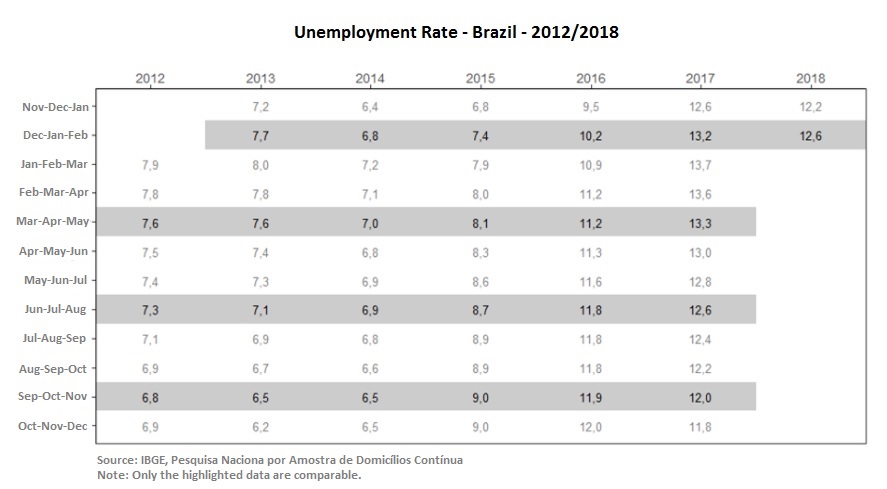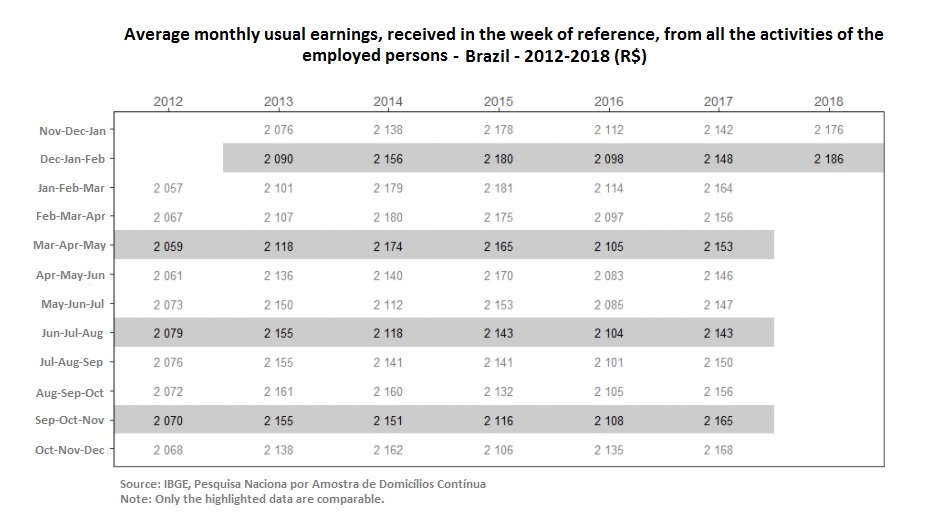Continuous Pnad: unemployment rate was 12.6% in the quarter ended February
March 29, 2018 09h00 AM | Last Updated: March 29, 2018 05h39 PM
The unemployment rate (12.6%) in the quarter December 2017 - February 2018 0.6 percentage points against that of the quarter September - November 2017 (12.0%). In comparison with the equivalent moving quarter a year ago (13.2%), there was decrease (-0.6 percentage points).
The unemployed population (13.1 million) increased 4.4%, that is, by 550 thousand persons against the previous quarter (12.6 million). In comparison with the same quarter a year ago, when there were 13.5 million unemployed persons, there was decrease (-3.1% or 426 thousand persons in that condition).
The population out of the workforce (64.9 million persons) increased 0.8% (or by 537 thousand persons) against the quarter September - November 2017, and reached is highest level in the Continuous PNAD time series, initiated in 2012. Against the same quarter in 2017, there was stability.
The employed population (91.1 million) recorded a decrease (-0.9%, 858 thousand persons) against the previous quarter. Versus the same quarter in 2017, there was increase (2.0% oor 1.7% million employed persons more).
The number of workers with a formal contract (33.1 million) was stable against that of the previous quarter (September- November 2017). In comparison with the quarter December 2016/February 2017, there was decrease (-1.8% or 611 thousand persons). It was the lowest level sine the beggining of the time series, in 2012.
Workers without a formal contract (10.8 million) recorded a decrease (-3.6%, or 407 thousand persons) against the figure a quarter ago, but recorded increase of 5.0% (511 persons more) versus the same quarter a year ago.
The category of self-employed workers (23.1 million persons) remained stable in relation to the result of September-November 2017. Against the sme period a year ago, there was increase of 4.4% (977 thousand persons).
The average usual real earnings (R$ 2,186) in the quarter December 2017 - February 2018 was stable against the quarter September-November 2017 (R$ 2,165) and also aginst the same quarter a year ago (R$ 2,148).
The usual real wage bill (R$ 194.1 billion) was stable against that of the movbing quarter September-November 2017. in comparison with the same quarter a year ago, there was increase of 4.1%, or R$ 7.6 billion. The complete publication, the summary chart and the Continuous PNAD presentation are on the right of this page.
| Indicator / Period | Dec/17 - Jan/18 - Feb/18 | Sep - Oct - Nov 2017 | Dec/16 - Jan/17 - Feb/17 |
|---|---|---|---|
| Unemployment rate | 12.60% | 12.00% | 13.20% |
| Usual real earnings | R$2,186 | R$2,165 | R$2,148 |
| Change of the real usual earnings in relation to: | 1.3% (stability) | 2.1% (stability) | |
The unemployment rate was estimated at 12.6% in the quarterly moving average of December 2017-February 2018, having increased 0.6 percentage points in relation to that of September-November 2017 (12.0%). Against the same moving quarter in 2017 (13.2%), there was decrease (-0.6 percentage points).
In the quarter December 2017-February 2018, there were 13.1 million unemployed persons in Brazil. That figure recorded an increase of 4.4% against the quarter September-November 2017, when the estimated unemployment rate was 12.6 million persons. Against the same quarter in 2017, when there were 13.5 million unemployed persons, there was decrease of 3.1%.

The number of employed persons was estimated at 91.1 million in the quarter December 2017-February 2018, a decrease of 0.9% versus the previous one (858 thousand persons). In relation to the same quarter in 2017 (December 2016 to February 2017), there was increase of 2.0% (1.7 million persons more).
The employment population ratio (percentage of employed persons in the population at working age) was estimated at 53.9% in the quarter December 2017-February 2018, with a decrease of 0.6 percentage points against the result of September-November 2017. Against the same quarter a year ago, when the employment population ratio in Brazil was 53.4%, there was increase (0.5 percentage points).
The labor force (employed and unemployed persons) in the quarter December 2017-February 2018 was estimated at 104.2 million persons. The population remained stable in comparison with that of the quarter September-November 2017. Against the same quarter in 2017, there was increase of 1.3% (1.3 million persons).
The number of persons out of the labor force in the quarter December 2017-February 2018 was estimated at 64.9 million persons, 537 thousand persons more (0.8%) in relation to that of September-November 2017. Against the same quarter in 2017, there was stability. The figure reached its highest level in the Continuous PNAD times series, which started in 2012.
Workers with a formal contract in the private sector (except domestic workers), estimated at 33.1 million persons, remained stable against the figure of last quarter (September-November 2017). Against the asme quarter a year ago, there was decrease (-1.8%, 611 thousand persons). That figure reached its lowest level in the time series since 2012.
Those workers without a formal contract in the private sector (10.8 million persons) recorded a decrease (407 thousand persons, -3.6%) against the previous quarter. In comparison with the same quarter in the previous year, there was an increase of 5.0% (511 thousand persons).
The number of self-employed workers (23.1 million) remained stable in comparison with that of the previous quarter (September-November 2017). Versus the same period in the previous year, that figure increased by 4.4% (977 thousand persons).
Employers (4.4 million workers) remained stable in comparison with the previous quarter, and recorded an increase of 5.5% (225 thousand persons) against the same quarter in 2017.
Domestic workers (6.3 million persons) was stable versus the result of September-November 2017. Against the qujarter December 2016-February 2107, there was increase of 4.2% (251 thousand persons).
The group employed in the public sector (including military and civil servants), estimated at 11.2 million persons, recorded a decrease of 3.1% abgainst the previous quarter. In comparison with the same quarter in 2017, there was increase of 3.3% (359 thousand persons).
The analysis of groups of activity showed that there was not increase in any category compared to the previous quarter. There was decrease in the groups of Industry (-2.0%, or 244 thousand persons), Construction (-4.0%, or 277 thousand persons) and Public administration, defense, social security, education, human health and social services (-2.7%, or 435 thousand persons).
Versus the results of December 2016-February 2017, six groups recorded increase: Industry (3.3%, or 375 thousand persons), Lodging and feeding (5.5%, or 271 thousand persons), Information, communication and Financial, real estate, professional and administrative activities (3.3%, or 326 thousand persons), ublic administration, defense, social security, education, human health and social services (2.6%, or 390 thousand persons), Other services (9.5%, or more 407 thousand persons) and Domestic services (4.2%, or 256 thousand persons). Teo groups recorded decreases: Agriculture, livestock, forestry, fishing and aquaculture (3.2%, or thousand persons) and Construction (4.0%, or 280 thpusand persons).

The average usual real earnings (R$ 2,186) in the quarter December 2017-February 2018 recorded stability against the quarter September-November 2017 (R$ 2,165) and also against the same quarter in the previous year (R$ 2,148).
By groups of activity, the moving quarter December 2017-Frbruary 2018 recorded, in comparison with September-November 2017, increases in the category of Industry (3.3%, or R$ 70) and Domestic services (1.7%, or more R$ 14). The other groups did not record significant changes. In terms of the quarter December 2016-February 2017 there was increase in the categories: Industry (5.1%, or R$ 107) and Domestic services (2.3%, or R$ 20). The other groups did not record any significant changes.
The usual real wage bill from all the activities was estimated at R$ 194,1 billion in the quarter December 2017-February 2018. Versus the moving quarter September-November 2017, there was stability; versus the same quarter a year ago, there was an increase of 4.1% (R$ 7.6 billion).

